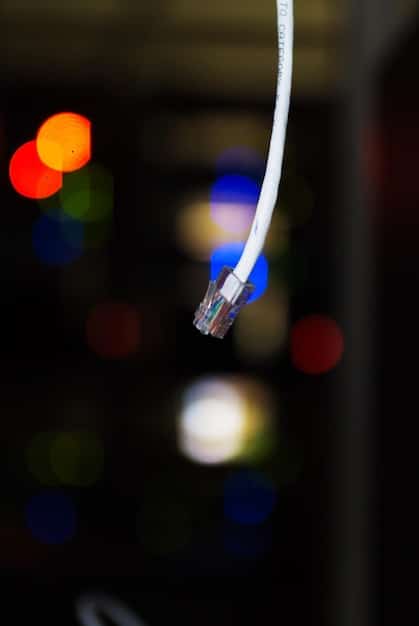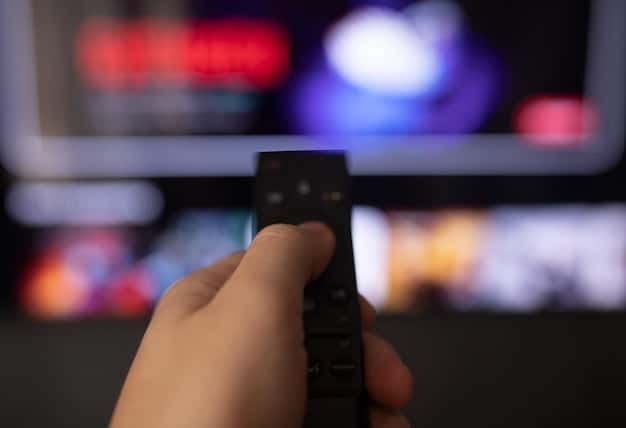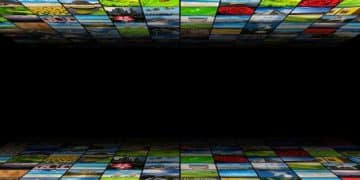Cutting the Cord in 2025: Streaming Costs vs. Cable Prices

The decision to cut the cord in 2025 involves comparing the total expenses of streaming services against traditional cable, factoring in internet costs, content preferences, and long-term affordability for US consumers seeking to optimize their entertainment budget.
Are you contemplating cutting the cord in 2025? This article dives deep into a data-driven analysis comparing the real costs of streaming versus cable, helping you make an informed decision about your entertainment spending.
Cutting the Cord in 2025: A Financial Crossroads
As we approach 2025, the question of whether to stick with traditional cable or fully embrace streaming services remains a hot topic. The allure of on-demand content and personalized viewing experiences has drawn many to streaming, but understanding the long-term financial implications is crucial.
This section will explore a comprehensive analysis of the costs associated with both cable and streaming, helping you determine which option provides the best value for your entertainment needs.
The Declining Cable Subscription
The traditional cable TV model is facing increasing pressure. Skyrocketing prices and long-term contracts have driven consumers to seek alternatives that offer more flexibility and control over their viewing experience.
- Cable companies are losing subscribers at an alarming rate.
- Many consumers feel cable packages include channels they never watch.
- The rise of high-speed internet has made streaming a viable alternative.
The Rise of Streaming Services
Streaming services have exploded in popularity, offering a wide range of content at various price points. From on-demand movies and TV shows to live sports and news, streaming platforms cater to diverse interests.
- Netflix, Hulu, Amazon Prime Video, and Disney+ are among the top streaming services.
- Many streaming services offer ad-free plans for a premium price.
- The number of streaming services is continually growing, offering consumers more choices than ever before.
In conclusion, this section has set the stage for a detailed cost comparison, highlighting the pressures on cable and the rise of streaming as dominant forces in the entertainment landscape.
Understanding the Base Costs: Internet is Key
Before even considering content, a high-speed internet connection is essential for both streaming and, increasingly, for modern cable services. Let’s break down these fundamental costs.
This section will dive into the expenses associated with obtaining a reliable internet connection, which forms the foundation of both cable and streaming entertainment.

Internet Service Providers (ISPs)
The cost of internet service varies widely depending on your location, provider, and the speed you require. Streaming in high definition or 4K resolution demands a robust and consistent internet connection.
- ISPs offer different speed tiers, with higher speeds costing more.
- Data caps can be a concern for heavy streamers.
- Bundling internet with cable may offer some cost savings, but not always.
Hidden Internet Costs
Beyond the monthly bill, be aware of additional costs like installation fees, equipment rental, and overage charges if you exceed your data cap. Reading the fine print of your internet contract is crucial.
- Installation fees can add a significant initial cost.
- Renting a modem and router from your ISP can be more expensive than buying your own.
- Monitor your data usage to avoid overage charges.
In summary, this section has underlined the importance of factoring in internet costs when comparing cable and streaming, emphasizing that reliable high-speed internet is a prerequisite for both.
Breaking Down Cable Costs in 2025
Cable TV packages in 2025 continue to evolve, yet understanding the components of your bill remains essential.
This section will dissect the various costs associated with a traditional cable TV subscription, including base packages, premium channels, equipment rental, and hidden fees.
Base Cable Packages
The foundation of your cable bill is the base package, which includes a predetermined selection of channels. The price of the base package depends on the number of channels and the type of content included.
Cable packages are often bundled, usually forcing you to pay for channels you don’t regularly watch.
Premium Channels and Add-ons
Premium channels like HBO, Showtime, and Starz come at an additional cost, typically ranging from $10 to $20 per month per channel. Sports packages and international channels also add to the overall expense.
This means your bill can easily increase, depending on your viewing preferences.

Equipment and Fees
Renting cable boxes, DVRs, and remote controls adds to your monthly bill. Many cable companies also charge broadcast TV fees and regional sports fees, which can significantly increase your overall cost.
- Cable box rentals can be surprisingly expensive.
- DVR service often comes with a monthly fee.
- Broadcast TV fees and regional sports fees are often hidden costs.
In conclusion, this section has peeled back the layers of a typical cable bill, revealing the various components that contribute to the overall cost, urging consumers to examine their bills carefully.
Calculating your Streaming Service Subscriptions
Streaming services offer diverse pricing plans and content libraries. It’s important to know which services align with your interests and how their costs accumulate.
This section will guide you through assessing your streaming needs, comparing subscription costs, and identifying potential savings through bundling or rotating subscriptions.
Identifying Your Streaming Needs
Start by identifying the type of content you enjoy watching. Do you prefer movies, TV shows, sports, news, or documentaries? Different streaming services specialize in different types of content.
Being clear about what you enjoy can help narrow down what you actually need to be paying for.
Comparing Subscription Costs
Compare the monthly costs of various streaming services. Netflix, Hulu, Amazon Prime Video, Disney+, HBO Max, and Paramount+ all have different pricing tiers. Consider whether you need ad-free viewing or 4K resolution, as these features often come at a premium.
Bundling and Rotating Subscriptions
Some streaming services offer bundles that can save you money. For example, Disney offers a bundle that includes Disney+, Hulu, and ESPN+. You can also rotate subscriptions, subscribing to a service for a month or two to watch specific shows or movies and then canceling until new content becomes available.
- Bundling can significantly reduce your overall streaming costs.
- Rotating subscriptions allows you to save money by only paying for the services you’re actively using.
- Consider sharing subscriptions with family or friends to split the cost.
In summary, this section has empowered readers to evaluate their streaming needs, compare subscription costs, and explore strategies for saving money through bundling or rotating subscriptions.
Data-Driven Comparison: Streaming vs. Cable in 2025
With costs outlined for both cable and streaming, let’s put these numbers side-by-side for a clear comparison. Consider your viewing habits and preferences to tailor the analysis.
This section presents a data-driven comparison of the average monthly costs of cable and streaming, accounting for internet expenses, content preferences, and viewing habits.
Average Monthly Costs
The average cable TV package costs around $100 per month, including equipment rental and fees. Streaming services, on the other hand, can range from $10 to $80 per month, depending on the number of subscriptions you have.
It is easy to see how this can change depending on your cable and/or streaming packages.
Viewing Habits and Customization
If you watch a wide variety of channels and prefer live TV, cable may still be a viable option. However, if you primarily watch on-demand content and are willing to curate your streaming subscriptions, you can likely save money.
For example, sports fans get a lot of value out of cable, but that value is lost on those who do not watch sports; they likely save money by switching to streaming.
Long-Term Costs and Contracts
Cable contracts often lock you in for a year or two, with early termination fees if you cancel. Streaming services, on the other hand, typically offer month-to-month subscriptions with no long-term commitments.
- Cable contracts can be restrictive and costly.
- Streaming services offer more flexibility and control.
In conclusion, a comprehensive comparison of the costs associated with various options is always advised.
Future Trends and Predictions
The entertainment landscape is continually evolving. New technologies and changing consumer behavior will shape the future of both cable and streaming.
This section will explore upcoming trends in both the cable and streaming industries, including advancements in technology, changing consumer preferences, and the potential impact of new market entrants.
The Future of Cable
Cable companies are adapting to the changing landscape by offering streaming services and online platforms. Some are also exploring partnerships with streaming providers to offer bundled packages.
For instance, some are adding streaming options to complement their cable packages.
The Evolution of Streaming
Streaming services are expected to continue to grow and evolve. We may see more consolidation in the industry, with larger companies acquiring smaller services. New technologies, such as 5G and cloud gaming, will also impact the streaming experience.
- The streaming landscape is becoming increasingly competitive.
- 5G and cloud gaming will enhance the streaming experience.
- Personalized content recommendations will become more sophisticated.
In summary, this section has explored the future trajectory of both cable and streaming, emphasizing the rapid pace of change and the importance of adapting to new technologies and consumer preferences. Predicting the future is always extremely difficulty, but it can be useful.
| Key Point | Brief Description |
|---|---|
| 💡 Internet Costs | Essential for both cable and streaming; factor in speed and data caps. |
| 💰 Cable Expenses | Include base packages, premium channels, equipment rentals, and fees. |
| 🎬 Streaming Costs | Vary by service; consider bundling or rotating subscriptions to save. |
| 🔮 Future Trends | Cable adapts with streaming options; streaming evolves with technology and consolidation. |
FAQ
▼
The number of streaming services you subscribe to, the resolution (HD or 4K), and whether you choose ad-free plans significantly impact streaming costs. Bundling options can help reduce the overall expense.
▼
Yes, cable subscriptions often include hidden fees such as broadcast TV fees, regional sports fees, and equipment rental charges. These fees can substantially increase your monthly bill beyond the advertised price.
▼
A faster internet plan ensures smoother streaming and higher resolution content, but it also increases your monthly internet bill. Consider your streaming habits and the number of devices using the internet simultaneously when choosing a plan.
▼
Yes, rotating subscriptions allows you to subscribe to a service only when there’s content you want to watch, then cancel it. This can save you money compared to maintaining multiple subscriptions year-round.
▼
Cable companies are now offering streaming services, online platforms, and partnerships with streaming providers to offer bundled packages. These efforts aim to provide more flexible and cost-effective options for consumers.
Conclusion
Ultimately, the decision to cut the cord in 2025 depends on your individual viewing habits, budget, and content preferences. By carefully analyzing the costs associated with both cable and streaming, and considering future trends in the entertainment industry, you can make an informed choice that best suits your needs.





